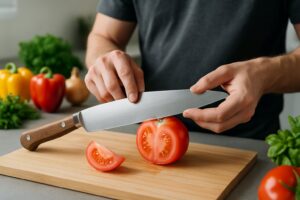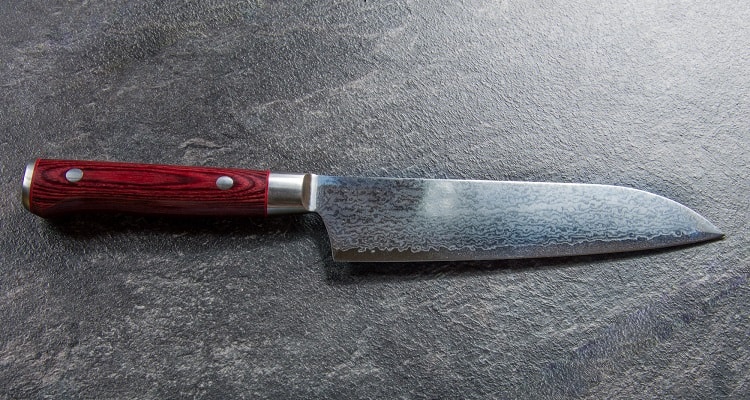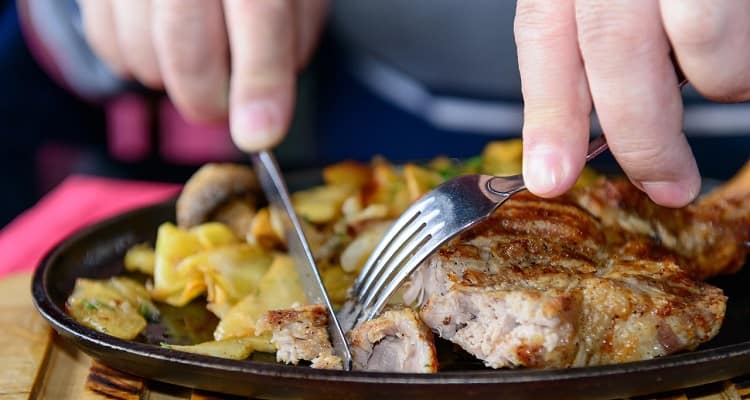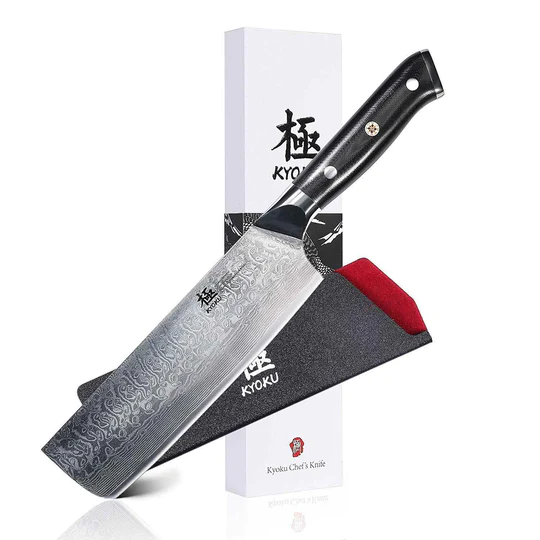


When you shop for a quality knife, the handle material can make a big difference in your cooking experience. Pakkawood is an excellent choice for knife handles because it combines the natural beauty of wood with enhanced durability and water resistance that surpasses traditional wood materials.
Learn how this innovative material is made, why it outperforms other handle options, and whether it’s right for your kitchen. This review also lists other products that use Pakkawood for strength and durability.
Pakkawood is a wood-resin composite that is popular in high-end chef knives and professional kitchen tools. Unlike natural wood that can warp, crack, or harbor bacteria, Pakkawood maintains its strength and appearance even with heavy daily use.
A normal Pakkawood knife consists of 70% hardwood veneers and 30% epoxy resin. The thin layers of hardwood provide the natural appearance and texture on the finished handle. The resin binds everything together and fills the wood fibers, creating a waterproof barrier.
Pakkawood comes in natural wood colors or bright artificial shades. The dyes penetrate the wood fibers during resin impregnation, creating consistent color throughout the material.
Common Colors:
Pakkawood handles stand out from other knife handles. Your Pakkawood knife handle won’t crack or split like natural wood handles. The resin fills gaps in the wood fibers, making the handle solid and stable.
High-end chef knives often use Pakkawood because professional kitchens need handles that last for years. The material holds up to constant chopping, slicing, and washing cycles.
Pakkawood handles resist water damage much better than natural wood options. The phenolic resin creates a barrier that prevents water from soaking into the wood fibers.
Water resistance benefits:

Pakkawood handles have a glossy finish that looks polished. The finish resists scratches and wear marks, makes cleaning easier, and helps prevent bacteria buildup.
Japanese knife makers often choose Pakkawood for their premium knife sets. The material complements the precision and craftsmanship of Japanese steel. Major brands like Shun Cutlery, Miyabi, and Cangshan use this composite material because of its durability and grip.
Shun Cutlery uses Pakkawood in their professional-grade knives. The handles provide the balance needed for precise cutting techniques in Japanese cooking.
Pakkawood is also used on Gyuto knives, Nakiri knives, and other Japanese specialty blades. The material’s density matches well with the weight of high-carbon Japanese steel.
Many steak knife sets feature Pakkawood handles because they maintain their appearance over time and don’t require special oils or treatments like traditional wood handles.
Thanks to its strength and range of colors, Pakkawood is used in a wide range of products:
Pakkawood offers clear advantages over traditional wood handles like walnut and oak. Engineered alternatives like Colorwood provide similar benefits with different characteristics. The main differences are in durability, water resistance, and consistent appearance.
Natural walnut and oak handles look beautiful but have significant drawbacks. These woods are porous and can crack, split, or warp over time with regular use.
Natural wood is porous and can adhere to bacterial or fungal invasion with long use. Walnut handles need regular oiling to prevent drying out. Oak requires similar maintenance to avoid cracking.
Pakkawood solves these problems. The resin composite makes it non-porous and resistant to bacteria growth. You don’t need to oil or condition Pakkawood handles like walnut or oak.
Durability comparison:

Staminawood and Colorwood are engineered materials similar to Pakkawood. All three combine wood veneers with resin for enhanced durability.
Staminawood uses a different resin formula that creates a slightly different feel. The material feels harder than Pakkawood but less smooth to the touch.
Colorwood offers more vibrant color options than standard Pakkawood. The dyes in Colorwood penetrate deeper into the wood layers, creating more consistent coloring throughout the handle.
Key differences:
All three materials resist water and heat better than natural wood. Choose based on your preference for smoothness, hardness, or color variety.

Natural wood grain varies significantly even within the same species. Walnut grain patterns range from straight to highly figured. Oak shows distinct ray patterns and ring structures.
Pakkawood grain patterns are more predictable. During creation, dyes are sometimes added to give the Pakkawood a look similar to other common types of hardwoods. You can get a consistent walnut or oak appearance without natural variations.
The resin in Pakkawood fills wood pores completely, creating a smoother surface than natural wood grain. Natural walnut and oak have open pores that create texture.
Appearance characteristics:
Pakkawood handles keep their appearance longer than natural wood. The resin protects against UV damage and daily wear that dulls natural wood finishes.

Pakkawood knife handles offer advantages in durability and water resistance compared to natural wood. Many users have questions about dishwasher safety, maintenance, and how this engineered material performs in the kitchen.
Pakkawood provides superior durability and water resistance compared to natural wood handles. The material combines hardwood veneers with phenolic resins under extreme heat and pressure.
You get a handle that resists cracking and splitting during heavy use. The engineered construction makes it stronger than regular wood.
Pakkawood handles offer excellent grip capabilities which reduces accident risk. The material keeps its shape and texture with frequent handling.
The handles come in various colors and patterns to match different kitchen styles and preferences.
Pakkawood outperforms natural wood in durability tests. The resin impregnation process removes many weaknesses found in regular wood.
Natural wood can crack, warp, or split over time. Pakkawood maintains its structural integrity under heavy use.
You won’t see the moisture damage that affects traditional wood handles. The composite construction prevents the expansion and contraction that weakens natural wood.
Pakkawood’s density makes it more resistant to dents and scratches. Your knife handles will keep their appearance longer than natural wood alternatives.
Pakkawood knives are not dishwasher safe despite their water-resistant properties. The wood veneer cannot handle long soaks in soapy water. You should hand wash your Pakkawood knives immediately after use. This prevents damage to both the handle and the blade.
The dishwasher’s high heat and extended water exposure can damage the handle material. Even water-resistant materials have limits. Hand washing and drying your knives preserves the handle’s integrity and appearance. This applies to all high-quality kitchen knives.

Pakkawood uses phenolic resins considered food-safe when properly cured. The manufacturing process uses high heat to stabilize the resin.
You don’t need to worry about toxic leaching during normal kitchen use. The material meets safety standards for food contact.
The resins in Pakkawood are thermoset plastics. Once cured, they remain stable and don’t release harmful chemicals.
Quality manufacturers ensure their Pakkawood meets food safety regulations. Choose knives from reputable brands that follow proper manufacturing standards.
Manufacturers form Pakkawood by selecting hardwood veneers and impregnating them with phenolic thermoset resins. This resin creates permanent chemical bonds when heated.
Phenolic thermoset resins do not melt once cured. This makes Pakkawood more stable than regular wood when exposed to heat and moisture. The resin soaks deep into the wood fibers, filling tiny gaps and creating a solid, dense material that resists cracking and splitting.
Resin Benefits:
Pakkawood demonstrates excellent heat and moisture resistance compared to natural wood. The resin treatment creates a barrier against water absorption.
You can use Pakkawood handles in hot kitchen environments without warping concerns. The material keeps its shape under normal cooking temperatures. Temperature changes won’t cause the expansion and contraction you see with natural wood. The engineered construction provides stability.
Moisture from washing and food preparation won’t damage properly maintained handles. The water resistance protects against most kitchen moisture.
Pakkawood needs minimal maintenance compared to natural wood handles. The material’s engineered construction resists common problems.
Clean your handles with mild soap and water after each use. Dry them thoroughly to prevent water spots or residue.
Avoid harsh chemicals or abrasive cleaners that can damage the surface. Gentle cleaning keeps the handle looking good and feeling smooth. And store your knives properly to prevent damage from contact with other utensils.

Knife Buzz offers independent product reviews on a wide range of knives used in the kitchen, home, and outdoors. We make it easy for you to find the right knife at the best price.